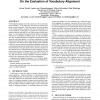Free Online Productivity Tools
i2Speak
i2Symbol
i2OCR
iTex2Img
iWeb2Print
iWeb2Shot
i2Type
iPdf2Split
iPdf2Merge
i2Bopomofo
i2Arabic
i2Style
i2Image
i2PDF
iLatex2Rtf
Sci2ools
203
Voted
KCAP
2011
ACM
2011
ACM
Let's agree to disagree: on the evaluation of vocabulary alignment
Gold standard mappings created by experts are at the core of alignment evaluation. At the same time, the process of manual evaluation is rarely discussed. While the practice of having multiple raters evaluate results is accepted, their level of agreement is often not measured. In this paper we describe three experiments in manual evaluation and study the way different raters evaluate mappings. We used alignments generated using different techniques and between vocabularies of different type. In each experiment, five raters evaluated alignments and talked through their decisions using the think aloud method. In all three experiments we found that inter-rater agreement was low and analyzed our data to find the reasons for it. Our analysis shows which variables can be controlled to affect the level of agreement including the mapping relations, the evaluation guidelines and the background of the raters. On the other hand, differences in the perception of raters, and the complexity of th...
Information Technology | KCAP 2011 | Knowledge Representation Formalisms | Manual Evaluation | Rater Agreement |
| Added | 16 Sep 2011 |
| Updated | 16 Sep 2011 |
| Type | Journal |
| Year | 2011 |
| Where | KCAP |
| Authors | Anna Tordai, Jacco van Ossenbruggen, Guus Schreiber, Bob J. Wielinga |
Comments (0)

